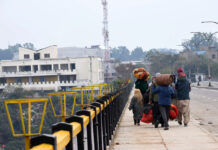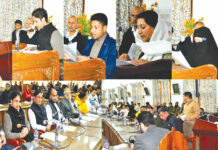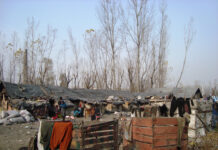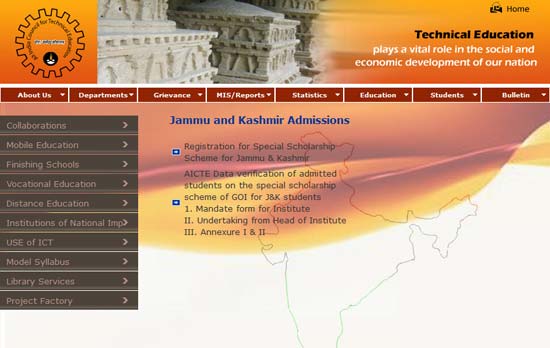Few documents have recorded the human rights abuse in Kashmir over the past 20 years. Even few have questioned the role of judiciary in safeguarding these rights. Zubair A. Dar reports one such document to be released Saturday.
As prominent supreme court lawyer Ashok Agrwaal presents his report on Saturday in Srinagar, it will be a slur on the face of judiciary in Kashmir in general and Jammu and Kashmir high court in particular. Denouncing the claims of fairness and integrity by Indian Judicial system, the report states that writ of habeas corpus is a complete failure in Kashmir as High Court even lacks control over its own establishment and the courts and officers subordinate to it.
The report also states that the Jammu and Kashmir High Court was not completely oblivious of the fact that it was playing out a ‘farce’.
The author ends the report with Faiz Ahmad Faiz’s poem, “Kaheen naheen hai, kaheen bhi naheen lahoo ka suraagh, Nah dast-o-naakhun-e-qaatil nah aasteen peh nishaan (There is no sign of blood, not anywhere. I’ve searched everywhere. The executioner’s hands are clean, his nails transparent. The sleeves of each assassin are spotless.)
“The remedy of habeas corpus is a complete failure in Kashmir. It (the judiciary) did not protect the right to life, nor did it punish those who violated it,” says the study published by Kathmandu-based South Asia Forum for Human Rights (SAFHR).
The 202-page report said that judiciary in Kashmir had merely perpetrated and perpetuated the ‘myth of justice and the myth of functioning’, particularly in cases of custodial deaths and missing persons.
“In over 57 percent of the cases in which there was a clear finding against an identified security force/unit, the Court found itself unable to do anything other than order registration of an FIR, which ought to have been done in the first place, without the Court’s intervention,” says the study, that details hundreds of cases of custodial disappearance and death in custody.
“To fully appreciate the absurdity of this we must also factor in the number of years that it took the Court to pass such an order,” Agrwaal writes adding that in 10 cases the order to register an FIR took between five to twelve years.
Finding itself unable to describe a justice system in which the ‘best order that the family of a disappeared person can expect – several years after the event – is a direction to the police to register an FIR’, the report says that there can be no more damning indictment of the system than this.
The report further claims that the reality was even worse. “We have records, and recorded testimony, to show that the registration of the FIR was seen by all concerned, the families, the police and, the judges as a mere formality, the completion of which would enable the system to wash its hands of the matter. The only expression of contrition that the system showed for its mistakes was in its willingness to consider the grant of ex-gratia compensation to the families of the disappeared,” Agrwaal says in the report.
About the Court’s ‘deliberate’ delay in processing the cases, the report says, “It is repeatedly seen that the Court did not pay attention to its earlier orders, acting – almost – as if on each date of hearing the entire matter was being dealt with afresh, ignoring all that was said and done in the past; as if the years of proceedings before that date never happened.”
“It seems to me such forgetfulness is essential for retaining a modicum of sanity in the schizophrenic environs of the J&K justice system.”
The report further says that Court’s delay in cases was giving “unscrupulous respondents and their lawyers” an advantage of this “amnesiac functioning” and helping them get away.
“The Court’s lack of control over its establishment … resulted in the staff of the Court frequently not carrying out the directions issued to it by the judges, with no fear of consequences,” says the report.
Quoting an example, the report says that in Manzoor Zargar’s case (90/6), the BSF took over five years to file their response to the petition. “In as many as 17 cases the respondents took more than two years to file their replies. In 30 cases they took between one year and two years to file their replies. Coupled with the fact that the accused unit of the armed forces did not file any reply at all in as many as 38 cases, the inference is clear,” says the report.
The report says that in 70 percent of the petitions in which the accused unit filed a response (41 cases out of 58), it was a bald denial of arrest. “Of the remaining responses, in 10 cases they admitted the arrest but claimed that the person concerned had been, subsequently, released. In three cases (pertaining to four persons) they claimed that the arrested persons had escaped from their custody. In four cases it was stated that the arrested persons were held in legally recorded and, acknowledged, custody after their arrest,” the report says.
“The conduct of the security forces was even more scornful once the case had been sent to the Inquiry Judge. In a very large number of the cases in which inquiries were ordered by the High Court, the accused unit did not participate in the inquiry proceedings. In several cases the Inquiry Judge recorded adverse remarks about the conduct of the accused unit, specifically attributing the delay in completing the inquiry to their tactics,” says the report. “In none of the inquiries did the security forces produce the records pertaining to the deployment of their troops, or those pertaining to the crackdowns that are a daily routine of life in Kashmir, or the records pertaining to the arrest/detention of people. Nor did they ever bring before the court any of the soldiers/officers responsible for the impugned actions.”
To illustrate this, the report details the case of Basharat Shah (91/12) where the CRPF made the Commandant and the Deputy Commandant of the 53 Bn to retire rather than produce them before the Inquiry Officer appointed by the High Court.
“That (BSF) they did not file a reply before the High Court, or that they did not participate in the inquiry proceedings, did not mean that the security forces were not following the proceedings. In several cases the accused unit of the armed forces did not file a reply before the High Court or cooperate in the judicial inquiry ordered but chose to file objections to the inquiry report; which had held against them. Thus, the picture is one of watchful disregard for the court and its processes. Wherever the security forces felt that they needed to intervene, they did so,” he report suggests.
The central government’s response too has been dealt in detail by the author. “In four petitions the police are on record as having completed their investigation and finalised a charge sheet against the officers/soldiers responsible for the arrest/disappearance. In two of these cases we have no information except for the fact that the police had stated before the Court that their investigation was complete and the charge sheet ready for being filed before the competent court. In two other cases, the High Court involved itself in monitoring and, to some extent, supervising the state government in the process of obtaining sanction from the central government. In both these cases the central government rejected the request for grant of sanction to prosecute the officers concerned.”
“These two cases are not the only ones in which the central government has refused the request for sanction. It is our information that the central government has granted sanction to prosecute in only two of the hundreds of cases in which such sanction was sought. In other words, it is reasonable to infer that the central government was/is not inclined to permit the courts to exercise jurisdiction and control over forces under its command.”
The report says that the case of Waheed Ahmad Ahangar (90/4), a 14 year old boy, epitomizes almost every aspect of the regime that Kashmiris live under.
“His arrest was witnessed by almost the entire locality since a very large force was deployed for it, with dozens of vehicles and scores of personnel. The police refused to register an FIR regarding his arrest, saying that there was a directive from the higher authorities. The family being fairly prosperous and well connected met the Director General of Police (DGP), Mr Saxena, who arranged for them to meet with him in custody. They met Waheed several times over the next six months. On 28 November 1990, two days before his sister’s wedding, Waheed’s family learnt that he was critically ill and in the intensive care ward of the army hospital at Badami Bagh. Though they got permission to meet him, a CID inspector intervened and pushed them out of the hospital. They have had no news of Waheed since then.”
Failing to secure his release even after meeting Rajesh Pilot in Delhi, who was then minister in charge of Kashmir affairs in the central cabinet, as part of a delegation representing parents of disappeared persons in Kashmir, Waheed’s father filed a habeas corpus petition before the High Court in November 1990. It took two years for the Court to order an inquiry and another two for the Court’s registry to communicate the order to the Inquiry Officer appointed for this purpose, says the report.
“The BSF admitted Waheed’s arrest before the inquiry and admitted he had been detained in PAPA-II. However, they claimed he was released after a 22 day detention since he had agreed to work for them. The release was claimed to have been effected through the PCR (Police Control Room) but they said there was no record of the release because, there was no system of making an entry in the PCR regarding the release of a suspect,” says the report. This process is still going on. Waheed’s father is not interested in compensation, though he has been offered it several times, report says.
Calling for a political resolve to rid New Delhi of this lawless impunity, the report concludes by saying that there was much that ailed the commitment of the Indian judicial system in Kashmir to uphold the right to life and the rule of law.
As prominent supreme court lawyer Ashok Agrwaal presents his report on Saturday in Srinagar, it will be a slur on the face of judiciary in Kashmir in general and Jammu and Kashmir high court in particular. Denouncing the claims of fairness and integrity by Indian Judicial system, the report states that writ of habeas corpus is a complete failure in Kashmir as High Court even lacks control over its own establishment and the courts and officers subordinate to it.
The report also states that the Jammu and Kashmir High Court was not completely oblivious of the fact that it was playing out a ‘farce’.
The author ends the report with Faiz Ahmad Faiz’s poem, “Kaheen naheen hai, kaheen bhi naheen lahoo ka suraagh, Nah dast-o-naakhun-e-qaatil nah aasteen peh nishaan (There is no sign of blood, not anywhere. I’ve searched everywhere. The executioner’s hands are clean, his nails transparent. The sleeves of each assassin are spotless.)
“The remedy of habeas corpus is a complete failure in Kashmir. It (the judiciary) did not protect the right to life, nor did it punish those who violated it,” says the study published by Kathmandu-based South Asia Forum for Human Rights (SAFHR).
The 202-page report said that judiciary in Kashmir had merely perpetrated and perpetuated the ‘myth of justice and the myth of functioning’, particularly in cases of custodial deaths and missing persons.
“In over 57 percent of the cases in which there was a clear finding against an identified security force/unit, the Court found itself unable to do anything other than order registration of an FIR, which ought to have been done in the first place, without the Court’s intervention,” says the study, that details hundreds of cases of custodial disappearance and death in custody.
“To fully appreciate the absurdity of this we must also factor in the number of years that it took the Court to pass such an order,” Agrwaal writes adding that in 10 cases the order to register an FIR took between five to twelve years.
Finding itself unable to describe a justice system in which the ‘best order that the family of a disappeared person can expect – several years after the event – is a direction to the police to register an FIR’, the report says that there can be no more damning indictment of the system than this.
The report further claims that the reality was even worse. “We have records, and recorded testimony, to show that the registration of the FIR was seen by all concerned, the families, the police and, the judges as a mere formality, the completion of which would enable the system to wash its hands of the matter. The only expression of contrition that the system showed for its mistakes was in its willingness to consider the grant of ex-gratia compensation to the families of the disappeared,” Agrwaal says in the report.
About the Court’s ‘deliberate’ delay in processing the cases, the report says, “It is repeatedly seen that the Court did not pay attention to its earlier orders, acting – almost – as if on each date of hearing the entire matter was being dealt with afresh, ignoring all that was said and done in the past; as if the years of proceedings before that date never happened.”
“It seems to me such forgetfulness is essential for retaining a modicum of sanity in the schizophrenic environs of the J&K justice system.”
The report further says that Court’s delay in cases was giving “unscrupulous respondents and their lawyers” an advantage of this “amnesiac functioning” and helping them get away.
“The Court’s lack of control over its establishment … resulted in the staff of the Court frequently not carrying out the directions issued to it by the judges, with no fear of consequences,” says the report.
Quoting an example, the report says that in Manzoor Zargar’s case (90/6), the BSF took over five years to file their response to the petition. “In as many as 17 cases the respondents took more than two years to file their replies. In 30 cases they took between one year and two years to file their replies. Coupled with the fact that the accused unit of the armed forces did not file any reply at all in as many as 38 cases, the inference is clear,” says the report.
The report says that in 70 percent of the petitions in which the accused unit filed a response (41 cases out of 58), it was a bald denial of arrest. “Of the remaining responses, in 10 cases they admitted the arrest but claimed that the person concerned had been, subsequently, released. In three cases (pertaining to four persons) they claimed that the arrested persons had escaped from their custody. In four cases it was stated that the arrested persons were held in legally recorded and, acknowledged, custody after their arrest,” the report says.
“The conduct of the security forces was even more scornful once the case had been sent to the Inquiry Judge. In a very large number of the cases in which inquiries were ordered by the High Court, the accused unit did not participate in the inquiry proceedings. In several cases the Inquiry Judge recorded adverse remarks about the conduct of the accused unit, specifically attributing the delay in completing the inquiry to their tactics,” says the report. “In none of the inquiries did the security forces produce the records pertaining to the deployment of their troops, or those pertaining to the crackdowns that are a daily routine of life in Kashmir, or the records pertaining to the arrest/detention of people. Nor did they ever bring before the court any of the soldiers/officers responsible for the impugned actions.”
To illustrate this, the report details the case of Basharat Shah (91/12) where the CRPF made the Commandant and the Deputy Commandant of the 53 Bn to retire rather than produce them before the Inquiry Officer appointed by the High Court.
“That (BSF) they did not file a reply before the High Court, or that they did not participate in the inquiry proceedings, did not mean that the security forces were not following the proceedings. In several cases the accused unit of the armed forces did not file a reply before the High Court or cooperate in the judicial inquiry ordered but chose to file objections to the inquiry report; which had held against them. Thus, the picture is one of watchful disregard for the court and its processes. Wherever the security forces felt that they needed to intervene, they did so,” he report suggests.
The central government’s response too has been dealt in detail by the author. “In four petitions the police are on record as having completed their investigation and finalised a charge sheet against the officers/soldiers responsible for the arrest/disappearance. In two of these cases we have no information except for the fact that the police had stated before the Court that their investigation was complete and the charge sheet ready for being filed before the competent court. In two other cases, the High Court involved itself in monitoring and, to some extent, supervising the state government in the process of obtaining sanction from the central government. In both these cases the central government rejected the request for grant of sanction to prosecute the officers concerned.”
“These two cases are not the only ones in which the central government has refused the request for sanction. It is our information that the central government has granted sanction to prosecute in only two of the hundreds of cases in which such sanction was sought. In other words, it is reasonable to infer that the central government was/is not inclined to permit the courts to exercise jurisdiction and control over forces under its command.”
The report says that the case of Waheed Ahmad Ahangar (90/4), a 14 year old boy, epitomizes almost every aspect of the regime that Kashmiris live under.
“His arrest was witnessed by almost the entire locality since a very large force was deployed for it, with dozens of vehicles and scores of personnel. The police refused to register an FIR regarding his arrest, saying that there was a directive from the higher authorities. The family being fairly prosperous and well connected met the Director General of Police (DGP), Mr Saxena, who arranged for them to meet with him in custody. They met Waheed several times over the next six months. On 28 November 1990, two days before his sister’s wedding, Waheed’s family learnt that he was critically ill and in the intensive care ward of the army hospital at Badami Bagh. Though they got permission to meet him, a CID inspector intervened and pushed them out of the hospital. They have had no news of Waheed since then.”
Failing to secure his release even after meeting Rajesh Pilot in Delhi, who was then minister in charge of Kashmir affairs in the central cabinet, as part of a delegation representing parents of disappeared persons in Kashmir, Waheed’s father filed a habeas corpus petition before the High Court in November 1990. It took two years for the Court to order an inquiry and another two for the Court’s registry to communicate the order to the Inquiry Officer appointed for this purpose, says the report.
“The BSF admitted Waheed’s arrest before the inquiry and admitted he had been detained in PAPA-II. However, they claimed he was released after a 22 day detention since he had agreed to work for them. The release was claimed to have been effected through the PCR (Police Control Room) but they said there was no record of the release because, there was no system of making an entry in the PCR regarding the release of a suspect,” says the report. This process is still going on. Waheed’s father is not interested in compensation, though he has been offered it several times, report says.
Calling for a political resolve to rid New Delhi of this lawless impunity, the report concludes by saying that there was much that ailed the commitment of the Indian judicial system in Kashmir to uphold the right to life and the rule of law.













